
Super Mario Kart is a kart racing game developed and published by Nintendo for the Super Nintendo Entertainment System (SNES). The first game in the Mario Kart series, it was released in Japan and North America in 1992, and in Europe the following year in 1993. Selling 8.76 million copies worldwide, the game went on to become the fourth best-selling SNES game of all time. Super Mario Kart was re-released on the Wii's Virtual Console in 2009, on the Wii U's Virtual Console in 2013, and on the New Nintendo 3DS's Virtual Console in 2016. Nintendo re-released Super Mario Kart in 2017 as part of the company's Super NES Classic Edition.

Tony Hawk's Pro Skater, released as Tony Hawk's Skateboarding in the UK, Australia, New Zealand, and parts of Europe, is a skateboarding video game developed by Neversoft and published by Activision. It was released for the PlayStation on September 29, 1999 and was later ported to the Nintendo 64, Game Boy Color, Dreamcast, and N-Gage.

Star Wars Jedi Knight: Jedi Academy is a first- and third-person shooter video game developed by Raven Software and published by LucasArts for Microsoft Windows, OS X and Xbox in 2003. Vicarious Visions was responsible for the development of the Xbox version. The game is a sequel to 2002's Star Wars Jedi Knight II: Jedi Outcast and the fourth and final installment in the Star Wars: Jedi Knight series. The single-player story, set in the fictional Star Wars expanded universe two years after Jedi Outcast, follows Jaden Korr, a new student at Luke Skywalker's Jedi Academy under the tutelage of the previous games' protagonist, Kyle Katarn. As Jaden, players are tasked with investigating a Dark Jedi cult called the Disciples of Ragnos, while slowly learning the ways of the Force and committing themselves to either the light side or the dark side.

Tony Hawk's Underground is a 2003 skateboarding video game and the fifth entry in the Tony Hawk's series after Tony Hawk's Pro Skater 4. It was developed by Neversoft and published by Activision in 2003 for the GameCube, PlayStation 2, Xbox, and Game Boy Advance. In 2004, it was published for Microsoft Windows in Australia and New Zealand as a budget release.

Tony Hawk's Pro Skater 2 is a skateboarding video game developed by Neversoft and published by Activision. It is the second installment in the Tony Hawk's series of sports games and was released for the PlayStation in 2000, with subsequent ports to Microsoft Windows, Game Boy Color, and Dreamcast the same year. In 2001, the game was ported to the Mac OS, Game Boy Advance, Nintendo 64, and Xbox. The game was later ported to Windows Mobile and Windows Phone devices in 2006 and to iOS devices in 2010.
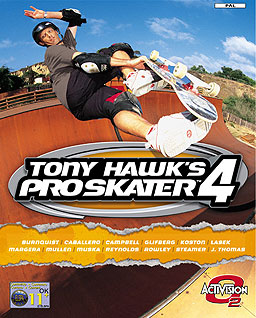
Tony Hawk's Pro Skater 4 is a 2002 skateboarding game developed by Neversoft and published by Activision under their Activision O2 label. The game was ported by different developers to various systems. It is the fourth installment in the Tony Hawk's series. The game was released in 2002 for the GameCube, PlayStation, PlayStation 2, Xbox, and Game Boy Advance. In 2003, it was published for Microsoft Windows and Mac OS X. In 2004, a Tapwave Zodiac version was released.

Tony Hawk's Underground 2 is a 2004 skateboarding video game, the sixth entry in the Tony Hawk's series after Tony Hawk's Underground. It was developed by Neversoft and published by Activision on October 4, 2004 in the U.S. for the PlayStation 2, Xbox, GameCube, Microsoft Windows, and Game Boy Advance platforms. The PlayStation Portable version was released in March 15 the following year, renamed Tony Hawk's Underground 2: Remix, which includes extra levels and characters.

1080° Snowboarding is a snowboarding video game developed and published by Nintendo for the Nintendo 64 in 1998. In the game, the player controls one of five snowboarders from a third-person perspective, using a combination of buttons to jump and perform tricks over eight levels.
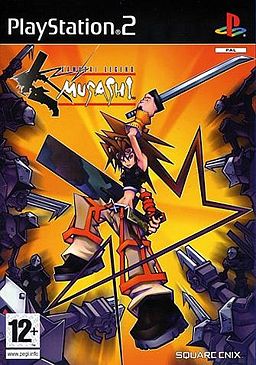
Musashi: Samurai Legend, known in Japan as Musashiden II: Blade Master, is a third-person action game developed by Square Enix in 2005 for PlayStation 2. Square Enix published the game in Japan and North America, while the game was released in PAL regions by Atari Europe.

Tetrisphere is a puzzle video game developed by H2O Entertainment and published by Nintendo for the Nintendo 64. It was released in North America on August 11, 1997, and in PAL regions in February 1998. The game, originally named Phear, was slated for release on the Atari Jaguar in early 1995, but was reworked into a Tetris game for the N64 after Nintendo obtained its publishing rights.

SSX 3 is a snowboarding video game developed by EA Canada and published by Electronic Arts under the EA Sports BIG label. The game was originally released on October 21, 2003, for the PlayStation 2, Xbox, and GameCube. It was later ported to the Game Boy Advance by Visual Impact on November 11, 2003, and to the Gizmondo by Exient Entertainment on August 31, 2005, as a launch title. It is the third installment in the SSX series.

Kirby 64: The Crystal Shards is a 2000 platform game developed by HAL Laboratory and published by Nintendo for the Nintendo 64 (N64). It is the first Kirby game to feature 3D computer graphics and follows Kirby as he attempts to reassemble a sacred crystal shattered by Dark Matter. Gameplay is viewed from a 2.5D perspective and is similar to previous Kirby titles; the player traverses levels and obtains powers by eating enemies. Kirby 64 introduces Power Combos, the ability to mix powers to create more powerful ones. In a multiplayer mode, up to four players can compete in three minigames.
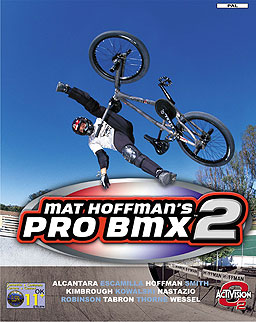
Mat Hoffman's Pro BMX 2 is a BMX video game endorsed by Mat Hoffman and published by Activision under the Activision O2 label. The game, which serves as a sequel to Mat Hoffman's Pro BMX, was released on August 13, 2002 for the PlayStation 2 and Xbox. A Game Boy Advance port was developed by HotGen and released the same day as the PlayStation 2 and Xbox versions. A GameCube port was developed by Gratuitous Games and was released on October 8, 2002.
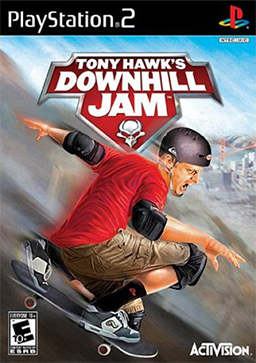
Tony Hawk's Downhill Jam is a skateboarding video game in the Tony Hawk's series. The game, named after the level "Downhill Jam" from Tony Hawk's Pro Skater, was published by Activision in 2006 as a timed Nintendo exclusive for the Nintendo DS, Game Boy Advance, and Wii. In 2007, it was published for the PlayStation 2. It is a spin-off in which accompanies the release of Tony Hawk's Project 8, which is conversely available on non-Nintendo systems.
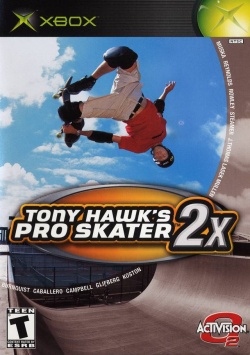
Tony Hawk's Pro Skater 2x is a 2001 skateboarding video game in the Tony Hawk's series. Developed in a collaboration between Neversoft and Treyarch, and published by Activision under the Activision O2 label, Pro Skater 2x is a re-release featuring the 19 levels from Tony Hawk's Pro Skater and Pro Skater 2, as well as five original levels. Some elements from the then-recently released Pro Skater 3 were included, along with other new features. It was released in North America for Xbox on November 15, 2001 as a launch title for the system.

Toxic Grind is an extreme sports game developed by Blue Shift Inc. and released by THQ for the Xbox in 2002. Described as the "only BMX game with a storyline" by the developers, Toxic Grind is a narrative BMX-based game in which players complete a series of missions within a futuristic game show over eleven levels. Similar to other extreme sports games of its type, the game features levels designed for players to complete tricks and avoid obstacles. Toxic Grind was originally planned for a multiplatform release with a GameCube port, although only the Xbox version reached release. The game was released to generally negative reviews, with critics mixed on the merits of the story additions to the game and the gameplay mechanics and control scheme.

Tony Hawk's Underground 2: Remix is a skateboarding video game in the Tony Hawk's series. The game, developed by Neversoft and Shaba Games and published by Activision, was released on March 24, 2005, as a launch title for the PlayStation Portable. Primarily a port of its console counterpart, the game featured a different progression, with four exclusive levels, exclusive characters, and new cutscenes. "Create-a-Park" was notably absent in the game, with some graphics and other aspects toned-down from the console version.

ESPN X Games Skateboarding is a video game developed by Konami for the PlayStation 2 and Game Boy Advance. The PlayStation 2 version was released in North America on August 14, 2001, in Japan on September 20, 2001, and in Europe on January 25, 2002, while the Game Boy Advance version was released in North America on September 12, 2001, in Japan on October 25, and in Europe on November 16. A release was planned in Australia, but was ultimately canceled. The game was released as part of Konami's ESPN The Games brand.

Mr. Driller 2 is a puzzle video game developed and published by Namco, and the second game in the Mr. Driller series. It was released for the arcades in 2000, and was ported to the Game Boy Advance and Windows in 2001, and is available in emulated form via the Virtual Console on the Wii U. The game introduces two new characters to the series, Puchi, and Anna.
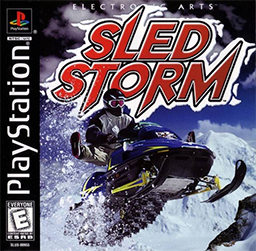
Sled Storm is a snowmobile racing video game published and developed by Electronic Arts. It gained critical acclaim due to its original concept of being one of the first snowmobile racing titles.




















